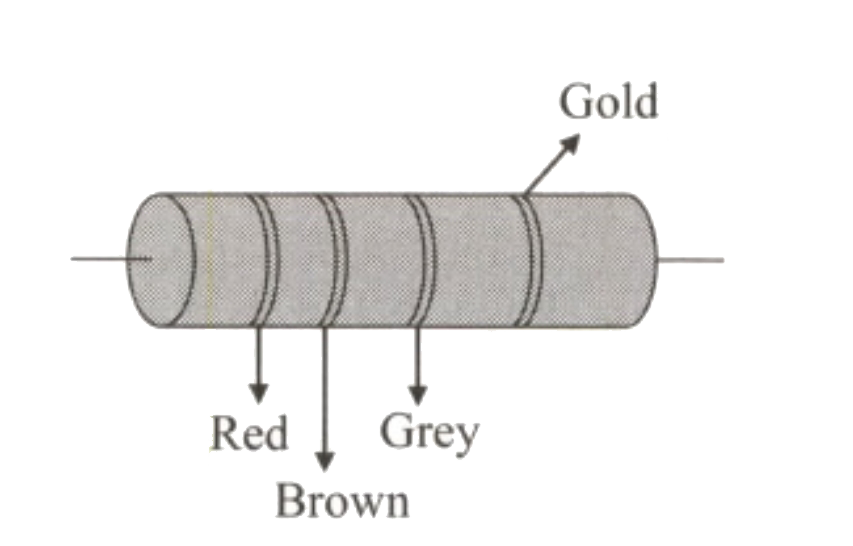The colour coded resistance of corbon resistance is (Initial three bands are red and fourth band is silcer)
222.Ω±10%
2200Ω±10%
333Ω±5%
33000Ω±10%
The correct Answer is:B
To solve the problem of determining the resistance value based on the color-coded bands of a carbon resistor, we will follow these steps:
1. Identify the Color Codes: The first three bands are red, red, and red, and the fourth band is silver.
- The color code for resistors is as follows:
- Red = 2
- Multiplier (Red) = 10^2 = 100
- Silver (Tolerance) = ±10%
2. Determine the Value from the First Two Bands:
- The first band (Red) represents the first digit: 2
- The second band (Red) represents the second digit: 2
3. Calculate the Resistance Value:
- Combine the first two digits to form a two-digit number: 22.
- The third band (Red) indicates the multiplier: 100 (which is 10^2).
- Therefore, the resistance value can be calculated as:
R=22×100=2200Ω
4. Determine the Tolerance:
- The fourth band (Silver) indicates the tolerance: ±10%.
5. Final Resistance Value:
- The final resistance value can be expressed as:
R=2200Ω±10%
Conclusion:
The resistance value of the carbon resistor is 2200 Ω ± 10%.
- The color code for resistors is as follows:
- Red = 2
- Multiplier (Red) = 10^2 = 100
- Silver (Tolerance) = ±10%
- The first band (Red) represents the first digit: 2
- The second band (Red) represents the second digit: 2
- Combine the first two digits to form a two-digit number: 22.
- The third band (Red) indicates the multiplier: 100 (which is 10^2).
- Therefore, the resistance value can be calculated as:
R=22×100=2200Ω
- The fourth band (Silver) indicates the tolerance: ±10%.
- The final resistance value can be expressed as:
R=2200Ω±10%
The resistance value of the carbon resistor is 2200 Ω ± 10%.
Topper's Solved these Questions
- BOOK - AAKASH SERIESCHAPTER - APPENDICES ( REVISION EXERCISE )EXERCISE - REVISION EXERCISE (MOVING CHANGES & MEGNETISM)95videos
APPENDICES ( REVISION EXERCISE )
- BOOK - AAKASH SERIESCHAPTER - APPENDICES ( REVISION EXERCISE )EXERCISE - REVISION EXERCISE (MAGNETISM AND MATTER )52videos
APPENDICES ( REVISION EXERCISE )
- BOOK - AAKASH SERIESCHAPTER - APPENDICES ( REVISION EXERCISE )EXERCISE - REVISION EXERCISE (ELECTRIC POTENTIAL & CAPACITANCE )143videos
APPENDICES ( REVISION EXERCISE )
- BOOK - AAKASH SERIESCHAPTER - ALTERNATING CURRENTEXERCISE - EXERCISE - III24videos
ALTERNATING CURRENT
- BOOK - AAKASH SERIESCHAPTER - APPENDICES (REVISION EXERCISE)EXERCISE - LAW OF MOTION128videos
APPENDICES (REVISION EXERCISE)
Similar Questions
Knowledge Check
- Question 1 - Select One
The order of coloured rings in a carbon resistor is red, yellow, blue and silver. The resistance of the carbon resistor is
A24×106Ω±5%B24×106Ω±10%C34×104Ω±10%D26×104Ω±5%
In the colour coding system of carbon resistors, the tolerance (in %) shown by gold band is____.
View SolutionThe color code of a resistance is given below:

The value of resistance and tolerance , respectively areView Solutionshown a network of four resistance and three batteries

Mark the incorrect statement.View SolutionThree equal resistance each of 3Ω are in series and connected to cell of internal resistance one ohm. If three resistances are parallel and connected to the same cell. Then the ratio of the respective currents through the electric circuits in the two cases is
View SolutionThe figure below shows a colour-coded resistor. The resistance of this resistor is:
 View Solution
View SolutionIn a Wheatstone's bridge, three resistances P,Q and R connected in the three arms and the fourth arm is formed by two resistances S1andS2 connected in parallel. The condition for the bridge to be balanced will be
View SolutionIn a Wheatstone's bridge, three resistances P,Q and R connected in the three arms and the fourth arm is formed by two resistances S1andS2 connected in parallel. The condition for the bridge to be balanced will be
View Solution

